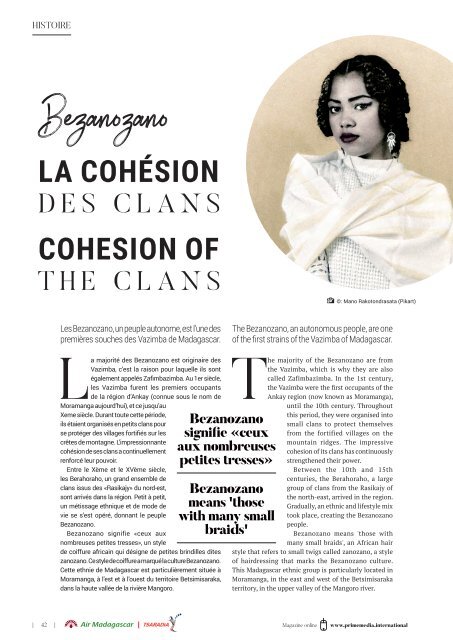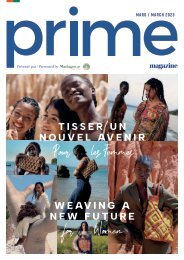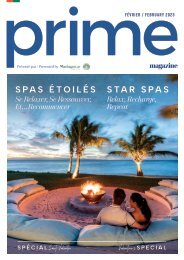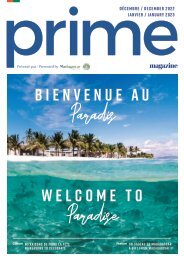Prime Magazine February 2020
You also want an ePaper? Increase the reach of your titles
YUMPU automatically turns print PDFs into web optimized ePapers that Google loves.
HISTOIRE<br />
Bezanozano<br />
LA COHÉSION<br />
DES CLANS<br />
COHESION OF<br />
THE CLANS<br />
©: Mano Rakotondrasata (Pikart)<br />
Les Bezanozano, un peuple autonome, est l’une des<br />
premières souches des Vazimba de Madagascar.<br />
The Bezanozano, an autonomous people, are one<br />
of the first strains of the Vazimba of Madagascar.<br />
L<br />
a majorité des Bezanozano est originaire des<br />
Vazimba, c’est la raison pour laquelle ils sont<br />
également appelés Zafimbazimba. Au 1er siècle,<br />
les Vazimba furent les premiers occupants<br />
de la région d’Ankay (connue sous le nom de<br />
Moramanga aujourd’hui), et ce jusqu’au<br />
Xeme siècle. Durant toute cette période,<br />
ils étaient organisés en petits clans pour<br />
se protéger des villages fortifiés sur les<br />
crêtes de montagne. L’impressionnante<br />
cohésion de ses clans a continuellement<br />
renforcé leur pouvoir.<br />
Entre le Xème et le XVème siècle,<br />
les Berahoraho, un grand ensemble de<br />
clans issus des «Rasikajy» du nord-est,<br />
sont arrivés dans la région. Petit à petit,<br />
un métissage ethnique et de mode de<br />
vie se s’est opéré, donnant le peuple<br />
Bezanozano.<br />
Bezanozano signifie «ceux aux<br />
nombreuses petites tresses», un style<br />
de coiffure africain qui désigne de petites brindilles dites<br />
zanozano. Ce style de coiffure a marqué la culture Bezanozano.<br />
Cette ethnie de Madagascar est particulièrement située à<br />
Moramanga, à l’est et à l’ouest du territoire Betsimisaraka,<br />
dans la haute vallée de la rivière Mangoro.<br />
Bezanozano<br />
signifie «ceux<br />
aux nombreuses<br />
petites tresses»<br />
Bezanozano<br />
means 'those<br />
with many small<br />
braids'<br />
The majority of the Bezanozano are from<br />
the Vazimba, which is why they are also<br />
called Zafimbazimba. In the 1st century,<br />
the Vazimba were the first occupants of the<br />
Ankay region (now known as Moramanga),<br />
until the 10th century. Throughout<br />
this period, they were organised into<br />
small clans to protect themselves<br />
from the fortified villages on the<br />
mountain ridges. The impressive<br />
cohesion of its clans has continuously<br />
strengthened their power.<br />
Between the 10th and 15th<br />
centuries, the Berahoraho, a large<br />
group of clans from the Rasikajy of<br />
the north-east, arrived in the region.<br />
Gradually, an ethnic and lifestyle mix<br />
took place, creating the Bezanozano<br />
people.<br />
Bezanozano means 'those with<br />
many small braids', an African hair<br />
style that refers to small twigs called zanozano, a style<br />
of hairdressing that marks the Bezanozano culture.<br />
This Madagascar ethnic group is particularly located in<br />
Moramanga, in the east and west of the Betsimisaraka<br />
territory, in the upper valley of the Mangoro river.<br />
| 42 | <strong>Magazine</strong> online www.primemedia.international

















